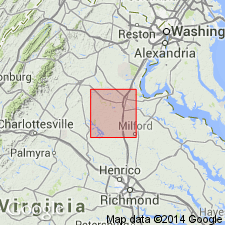
- Usage in publication:
-
- Falls Run Granite Gneiss*
- Modifications:
-
- Named
- Geochronologic dating
- Dominant lithology:
-
- Gneiss
- AAPG geologic province:
-
- Piedmont-Blue Ridge province
Summary:
Named as part of Fredericksburg Complex, replacing the name Berea quartz monzonite of Neuschel and others (1971); name Berea is preempted by Berea Sandstone. Named for Falls Run (upstream from typical exposures), Salem Church 7.5-min quad, Stafford Co., eastern VA. Occurs in a refolded fold that is on inverted limb of a recumbent fold. Consists of pale-pink to nearly white, coarse-grained, strongly foliated granite gneiss. Intruded by Holly Corner Gneiss of Fredericksburg Complex (both new). Age is Middle Silurian to Early Devonian based on U-Pb and Rb-Sr studies that date the unit as 415 to 385 Ma.
Source: GNU records (USGS DDS-6; Reston GNULEX).

- Usage in publication:
-
- Falls Run Granite Gneiss
- Modifications:
-
- Overview
- AAPG geologic province:
-
- Piedmont-Blue Ridge province
Summary:
Falls Run Granite Gneiss mapped in southern Stafford and northern Spotsylvania Cos. Fredericksburg Complex not used. Described as pink to white, coarse-grained, strongly-foliated hornblende-biotite granite to monzonite gneiss. Dominant minerals are microcline, plagioclase quartz, biotite, muscovite, and hornblende. Accessories include apatite, epidote, titanite, and magnetite-ilmenite. Intrudes Cambrian Ta River Metamorphic Suite and Late Proterozoic and Cambrian Holly Corners Gneiss. Intruded by Mississippian and Pennsylvanian Falmouth Intrusive Suite. Has been dated at 410 Ma (U-Pb zircon and Rb-Sr whole rock, Pavlides and others, 1982). Map symbol indicates a Silurian age.
Source: GNU records (USGS DDS-6; Reston GNULEX).
For more information, please contact Nancy Stamm, Geologic Names Committee Secretary.
Asterisk (*) indicates published by U.S. Geological Survey authors.
"No current usage" (†) implies that a name has been abandoned or has fallen into disuse. Former usage and, if known, replacement name given in parentheses ( ).
Slash (/) indicates name conflicts with nomenclatural guidelines (CSN, 1933; ACSN, 1961, 1970; NACSN, 1983, 2005, 2021). May be explained within brackets ([ ]).

